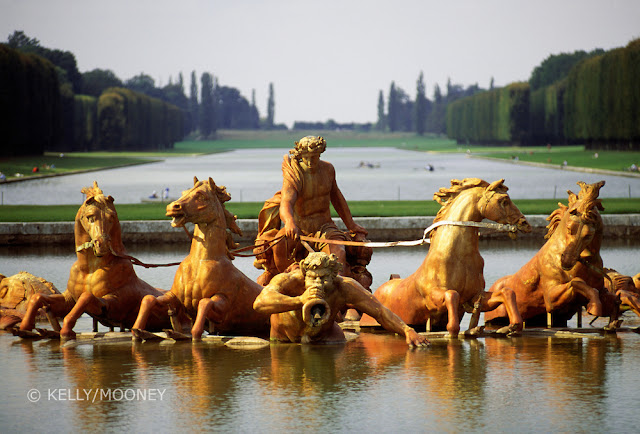 |
| Grand Trianon |
 |
| Garden around Grand Trianon |
There are many basquets or ornamental patterns of Baroque architecture. We missed viewing these artistically patterned groves which had been modified from time to time by the landscape artists. Andre Notre added or expanded not less than ten basquets during his lifetime. The Grand Trianon was set up as a formal garden with a modest palatial mansion for the king to enjoy his privacy. It is located nearly 1.5 kms to the north-west of the Versailles palace. This was designed and constructed by Jules Hardouin Mansart between 1670 and 1672. After the Revolution Napoleon restored it before he visited this on many occasions with his second wife, Empress Marie-Louiseof Austria. Afterwards in 1963 Charles de Gaulle converted it as a guesthouse for presidents of France and the northern wing as an official residence of French Presidents.
 |
| Pavilion of Petit Trianon |
 |
| Petit Trianon (Queen's private resort) |
 |
| Rural scenry at Queen's Petit Trianon |
The Petit Trianon was designed by Ange-Jacques Gabriel on the orders of Louis XV who gave it as a gift to his mistress, Madame de Pompadour. This pretty palace was constructed between 1762 and 1768. Later Louis XVI gifted it to his new bride, queen Marie-Antoinette who wished to enjoy the rural scenery of a village with fields and gardens. In 1785 Hamneau designed a stage village for the sake of the queen.
Louis XIV may be called the chief founder of the palace and the gardens. During the reign of Louis XV the Bassin de Neptune, the largest fountain, was completed. As an avid Botanist he laid out and maintained Les Jardins Botaniques (Botanical garden) in 1750 with the help of Claude Richard (1705-1784), the administrator of gardens. During Louis XVI's rule an attempt was made to re-plant trees in the style of English garden, but it did not work out and seemed inappropriate to the setting of the palace. So they reverted to the French style again. To maintain such a vast garden complex supply of water is the gravest challenge. Mostly water from the Grand Canal was mainly used. In 1685 a canal was designed by Vauban to supply water from the Eure river by constructing a dam, but it was nearly 80 kms away and hence the work had been given up in 1690.
As we were coming out quite exhausted feeling unable to cover the vast garden, we saw a few people driving hired taxis on the road through the garden. As we had no idea about this facility, we huffed and puffed walking through the garden. Our tour manager did not inform us about this facility to make our trip easy. But we derived a sense of satisfaction as we were able to enjoy, to pause and look at the sculptures, fountains and groves at a leisurely pace. To view such a spacious and beautiful garden one day is not enough. Most of the plants seen today do not belong to the olden times. Since 1992 the gardens have been being re-planted. In 1999 many trees were uprooted by the stormy gales. The French Ministry of Culture has been looking after the proper maintenance of the gardens. In 1979 the Versailles Gardens was recognized as the UNESCO World Heritage site.
In brief it is not an exaggeration to say that this royal garden is a veritable paradise on earth giving you a thrilling experience and filling your bosom with a sense of wonder and supreme joy.
***********************************
27th April, 2016 Somaseshu Gutala









































